Economical solutions to blast mitigation on bridges
Author(s)
DeRogatis, Austin (Austin Patrick)
DownloadFull printable version (6.886Mb)
Other Contributors
Massachusetts Institute of Technology. Dept. of Civil and Environmental Engineering.
Advisor
Jerome J. Connor.
Terms of use
Metadata
Show full item recordAbstract
Mitigating the energy created from a blast has been a topic of utmost importance in the terrorism-feared world of today. Main targets of concern are passageways that are significant to a specific area, such as bridges. These structures are expensive to construct and vulnerable to explosive loads which is why a cost-effective means of blast mitigation must be researched. There are many aspects of bridges that could be damaged when a blast load is applied. These susceptible areas can be strengthened using new-age, high-strength composite materials to ensure the security of the whole structure. These materials are able to sustain larger loads while dissipating higher amounts of energy when compared to conventional building materials. As a result, the response of the entire structure will be minimized when a blast load is applied. Despite the fact that these composites cost more than typical materials, the increase in project cost could be minimized by limiting the use of these high-strength materials for only the critical areas of the bridge. Other cost effective solutions to blast mitigation occur in the preliminary design phase. Eliminating all pressure-amplifying areas would save members and connections should a blast occur. Also, designing a bridge with high vertical clearances above areas of excessive boat traffic would also minimize the resultant forces and stresses from an explosion.
Description
Thesis (M. Eng.)--Massachusetts Institute of Technology, Dept. of Civil and Environmental Engineering, 2008. Includes bibliographical references (leaves 42-44).
Date issued
2008Department
Massachusetts Institute of Technology. Department of Civil and Environmental EngineeringPublisher
Massachusetts Institute of Technology
Keywords
Civil and Environmental Engineering.